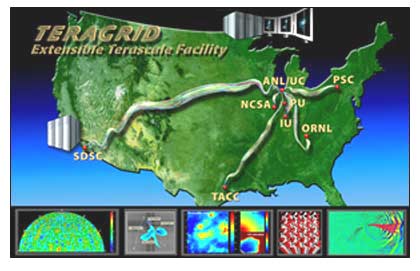ARLINGTON, Va., Aug. 18 -- The National Science Foundation (NSF) has made a five-year, $150 million award to operate and enhance the Extensible Terascale Facility (ETF)--also called "TeraGrid." NSF officials say researchers and educators around the country can now access a range of computing resources that will accelerate advances in science and engineering.
TeraGrid -- built over the past four years -- is an open scientific discovery infrastructure combining resources at eight partner sites to create an integrated, persistent computational resource. Through network connections, TeraGrid integrates high-performance computers, data resources and tools and high-end experimental facilities around the country. One example of this is the NanoHub, developed by the NSF's Network for Computational Nanotechnology based at Purdue University. NanoHub provides a web interface to numerous resources relevant to students and practitioners in nanotechnology. The cyber environment includes online courses and tutorials, proceedings of seminars, collaborative tools, access to the primary literature and an interface for online simulation. In the past year more than 1000 users have launched over 65,000 jobs using this interface.
 |
The Extensible Terascale Facility, or TeraGrid, an infrastructure for open scientific research, is being used by researchers from diverse scientific and engineering fields. (Graphic: N.R. Fuller, National Science Foundation. Bottom images [l-r]: [1] A. Silvestri, Amanda Project, University of California, Irvine; [2] B. Minsker, University of Illinois, Urbana-Champaign, using an MT3DMS model developed at the Army Corps of Engineers and modified by C. Zheng, University of Alabama; [3] M. Wheeler, University of Texas, Austin; J. Saltz, Ohio State University; M. Parashar, Rutgers University; [4] P. Coveney, University College London/Pittsburgh Supercomputing Center; [5] A. Chourasia, visualization services, San Diego Supercomputer Center and The Southern California Earthquake Center Community Modeling Environment)
|
The scientists and engineers responsible for TeraGrid operations will work closely with researchers whose science requires powerful computing resources. For example, researchers using TeraGrid are exploring functions of decoded genomes, how the brain works, the constitution of the universe, disease diagnosis and real-time weather forecasting to predict the exact locations of tornado and storm threats. TeraGrid will also help engineers design better aircraft via realistic simulations of new designs.
The new TeraGrid award includes $48 million to provide overall architecture, software integration, operations and coordination of user support. The University of Chicago will lead this effort under Charlie Catlett, director of the TeraGrid project and former chair of Global Grid Forum. An additional $100 million will provide for operation, management and user support of TeraGrid resources at the eight sites.
TeraGrid's creators and collaborators are developing a "science gateways" initiative to allow more researchers and educators access to TeraGrid capabilities, tailored to their own communities, through their own desktop computers. Science gateway projects are aimed at supporting access to TeraGrid via web portals, desktop applications or via other grids. An initial set of 10 gateways will address new scientific opportunities in fields from bioinformatics to nanotechnology as well as interoperation between TeraGrid and other grid infrastructures.
Officials say such access will enable researchers to analyze terabytes--trillions of bytes--of data collected by scientific instruments, telescopes, satellites and remote sensors, and that TeraGrid will allow researchers to manipulate enormous data sets to gain new insights into research questions and societal problems.
George Karniadakis, a professor of applied mathematics at Brown University, uses computational resources at four different TeraGrid sites simultaneously to address fluid dynamics problems. "The TeraGrid is a distributed supercomputer, a system with potentially unlimited capability for us. For the first time, we can simulate cardiovascular processes in the entire arterial tree," he said.
Thomas Jordan, director of the Southern California Earthquake Center at the University of Southern California, leads an effort to combine computational models from several disciplines to shed new light on the consequences of earthquakes. "TeraGrid is providing us with the computational resources to deploy an entirely new technology for seismic hazard analysis," Jordan said.
For more information, visit: www.teragrid.org